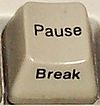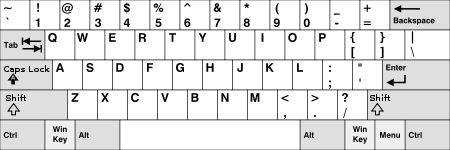- Break key
-
The origins of the break key on a computer keyboard go back to telegraph practices. A standard telegraph key has a built-in knife switch that can be used to short the key's contacts. When the key was not in use, that switch was kept closed, so that a signal was continually sent. If that steady-state signal was interrupted, it indicated one of two things: either the operator was about to start transmitting, or something else had happened to break the connection — such as a physical break in the telegraph line.
As the teleprinter came into use, a key was created that would temporarily interrupt the communications line, allowing this practice to continue. When this occurred, the receiving teleprinter mechanism would activate but not print characters (it was typing the non-printing DEL character repeatedly). The noise got the operator's attention.
Time-sharing computers connected to modems could recognize the break because the DEL characters received had "bad parity." This was used to generate an interrupt, allow login, or stop a running program.
On personal computers, the Break key can be used by software in several different ways, such as to switch between multiple login sessions, to terminate a program, or to interrupt a modem connection. On a BBC Micro computer, the Break key generates an interrupt which would normally cause a warm restart of the computer. A cold restart is triggered by typing Ctrl+break. If a DFS ROM is installed, Shift+break will cause the computer to search for and load a file called !boot on the floppy disk in drive 0.
On the Sinclair ZX80 and ZX81 computers, the Break is accessed by pressing Space. On the Sinclair ZX Spectrum it is accessed by Shift and Space. The Spectrum+ and later computers have a dedicated Break key. It does not trigger an interrupt but will halt any running BASIC program, or terminate the loading or saving of data to cassette tape. An interrupted BASIC program can usually be resumed with the CONTINUE command. The Sinclair QL computer, without a break key, maps the function to Ctrl+Space. On many modern PCs, Pause interrupts screen output by BIOS until another key is pressed. This is effective during boot in text mode and in a DOS box in Windows safe mode with 50 lines. On early keyboards without a Pause key (before the introduction of 101-key keyboards) the Pause function was assigned to Ctrl+NumLock, and the Break function to Ctrl+ScrLock; these key-combinations still work with most programs, even on modern PCs with modern keyboards. Pressing the dedicated Pause key on 101-key keyboards sends the same scancodes as pressing Ctrl, then NumLock, then releasing them in the reverse order would do; additionally, an e1hex prefix is sent which enables 101-key aware software to discern the two situations, while older software usually just ignores the prefix. The Pause key is different from all other keys in that it sends no scancodes at all on release; therefore it is not possible for any software to determine whether this key is being held down. [1]
On modern keyboards, the break key is usually labeled Pause/Break. In most Windows environments, the key combination Windows key+Pause brings up the system properties. Compact and notebook keyboards often have the Pause/Break key mapped to a function command: for example Ctrl+Fn+F11.
Usage for breaking the program's execution
While both Ctrl+Break and Ctrl+C combination are commonly implemented as a way of breaking the execution of a console application, they are also used for similar effect in integrated development environments.[2][3] Although these two are often considered interchangeable,[4] compilers and execution environments usually assign different signals to these.[5] Additionally, in some kernels (e.g. miscellaneous DOS variants) Ctrl+C is detected only at the time OS tries reading from a keyboard buffer and only if it's the only key sequence in the buffer,[6][7] while Ctrl+Break is often translated instantly (e.g. by INT 1Bh under DOS). Because of this, Ctrl+Break is usually a more effective choice under these OSes; sensitivity for these two combinations can be enhanced by the BREAK=ON CONFIG.SYS statement.
References
- ^ "Keyboard 101- and 102-Key". PS/2 Hardware Interface Technical Reference. IBM. October 1990. p. 19. http://www.mcamafia.de/pdf/ibm_hitrc11.pdf. "Except for the Pause key, all keys are make/break."
- ^ "CTRL+C (Break)". Msdn.microsoft.com. 2010-03-30. http://msdn.microsoft.com/en-us/library/ff540312.aspx. Retrieved 2010-10-22.
- ^ "Debug Break". Msdn.microsoft.com. 2010-03-30. http://msdn.microsoft.com/en-us/library/ff541727.aspx. Retrieved 2010-10-22.
- ^ "Ctrl-Break definition of Ctrl-Break in the Free Online Encyclopedia". Encyclopedia2.thefreedictionary.com. http://encyclopedia2.thefreedictionary.com/Ctrl-Break. Retrieved 2010-10-22.
- ^ http://www.gnu.org/software/emacs/windows/ntemacs/discuss/subproc-ctrl-c
- ^ "Vim documentation: vim online". Vim.org. http://www.vim.org/htmldoc/os_dos.html. Retrieved 2010-10-22.
- ^ "ClipX — DOS 5.0 Ref. - int 23h ctrl-c handler". Ousob.com. http://www.ousob.com/ng/dos5/ng27979.php. Retrieved 2010-10-22.
See also
- SysRq
- Scroll lock
- Num lock
Esc F1 F2 F3 F4 F5 F6 F7 F8 F9 F10 F11 F12 PrtScn/
SysRqScrLk Pause/
BreakIns Home PgUp Num Lock / * - Del End PgDn 7 8 9 + 4 5 6 ↑ 1 2 3 Ent ← ↓ → 0 . Keyboard keys Dead keys Modifier keys Lock keys Navigation Editing Misc. System request/Print screen · Break/Pause · Escape · Menu · Numeric keypad · Function · Power management (Power, Sleep, Wake) · Language input · any key · Macro key ·Categories:- Computer keys
- Out-of-band management
Wikimedia Foundation. 2010.


